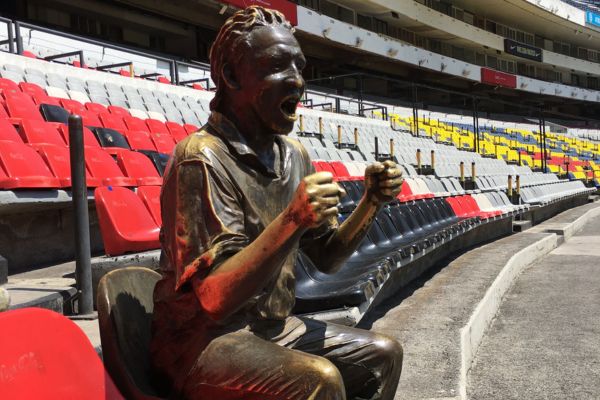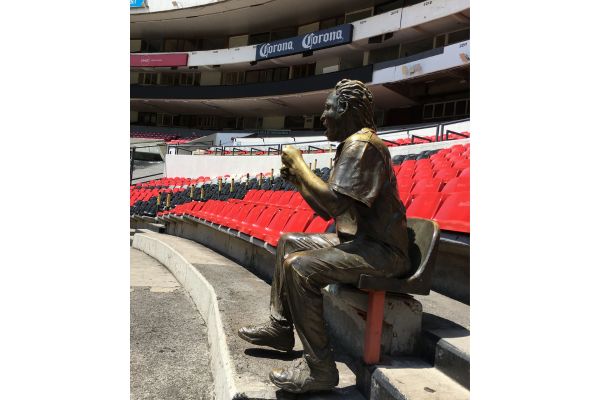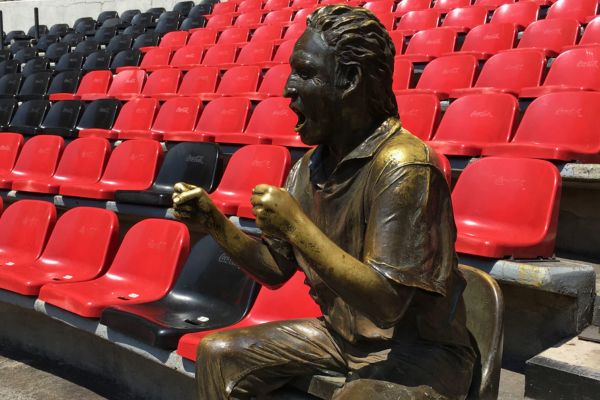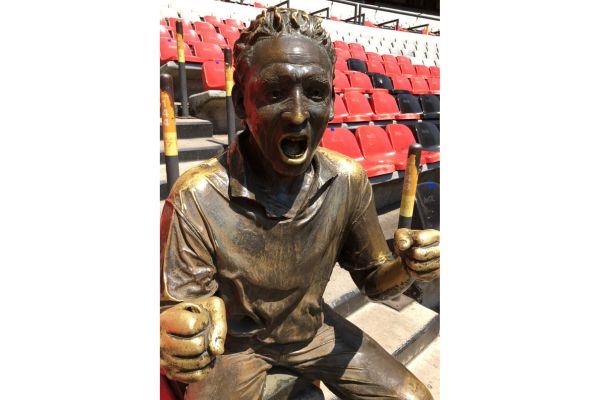“Falta poco, Nacho.”
One of the workers reassures him, hands covered in thick white plaster. The scene is a messy sculptor's workshop tucked away in Mexico City. Nacho, the devoted fan of Club América, has been sitting still for what feels like forever, arms frozen in a triumphant pose — fists clenched, mouth wide as if shouting in mid-celebration. His patience is wearing thin.
He can feel the weight of the plaster hardening on his body. From the neck down, he’s fully encased — a living mold. But the workers step back and admire their progress. “Ahora la cabeza,” one of them says. Now the head.
They’re not building a statue from sketches or guesswork — they’re building Nachito. What seems like a strange punishment is, in fact, a reward. This fan isn’t just passionate — he’s legendary. And this is the moment that turns his devotion into something eternal.
Here is Nachito’s story.
A Contest of Loyalty

To celebrate the 35th anniversary of Estadio Azteca, Televisa Deportes launched a unique competition: to find the stadium’s most loyal fan — someone who lived and breathed Club América.
Among the many hopefuls, one stood out. Ignacio Villanueva, known by everyone as Nachito, didn’t come with a dramatic speech or flashy banners. He arrived with a simple box — filled to the brim with ticket stubs, programs, and mementos from years of Club América matches.
His devotion wasn’t just claimed — it was documented. A decade’s worth of unwavering support spoke louder than any words could. Nachito was declared the winner. But his reward wasn’t just a trophy or a shoutout on TV — it was immortality.
Casting Devotion in Bronze

To honour his victory, sculptor Masha Zepeda was tasked with turning Nachito into something eternal. But this wasn’t just a statue based on photos or sketches. Nachito himself became the mold.
In a small studio in Mexico City, he stood frozen in a celebratory pose — fists clenched, mouth wide in a cheer, one leg slightly outstretched. The sculpting team carefully layered plaster over his entire body, capturing every detail with precision.
That mold was later cast into 120 kilograms of solid bronze, forever preserving the likeness of a fan who bled blue and yellow. It wasn’t just a statue — it was a love letter to football fandom.
A Seat of Honour in the Temple of Football

Nachito’s statue was unveiled inside the Estadio Azteca in 2001. Along with it came an exclusive seat just for him — a permanent place in the stands where he had cheered for so long.
To many, he wasn’t just a superfan. He was the spirit of the crowd — a symbol of how deep the bond between club and supporter can go. His recognition wasn’t just personal; it was a celebration of the millions who live football with the same intensity.
A Highlight of the Estadio Azteca Tour

Today, fans visiting Estadio Azteca can see Nachito’s statue on the official stadium tour. It’s not tucked away or hidden — it stands proudly as a testament to the beating heart of the sport: the fans.
Next to the echoes of past World Cup finals and club glories, Nachito’s bronze pose reminds visitors that while players make history, fans give it meaning.
A Silent Spectator in a Silent Stadium

In 2020, as the COVID-19 pandemic emptied stadiums across the globe, Nachito’s statue took on new meaning. With matches played behind closed doors, he became the lone spectator at Estadio Azteca.
While the roar of the crowd was gone, Nachito remained — fists clenched, frozen in mid-cheer, a symbol of passion that even a global shutdown couldn’t silence. For a time, he was the voice of the people when they couldn’t be there themselves.
The Heart of Football Lives Here

Ignacio Villanueva’s story is more than a quirky footnote in stadium history — it’s a reminder of the soul of the sport. His statue doesn’t just honour him; it honours everyone who has ever lived and breathed football from the stands.
In a world of billion-dollar transfers and global fame, Nachito is a beautiful reminder of what really matters: showing up, cheering loud, and loving your club with everything you’ve got.
Did You Know?
-
The Stadium Breaking Records in 2026 – Estadio Azteca is set to become the first stadium in history to host matches in three different World Cups.
-
Why Estadio Akron is Called the Volcano – Discover the fiery nickname behind another iconic Mexican stadium.
-
The Mexican Wave That Isn’t Actually Mexican – Uncover how a global fan phenomenon traces its roots back to 1986 and the Azteca’s electrifying crowds.
